17 janv 2026
KCF Est :
Oryzias & Galette des rois.
En savoir +
25-26 janv 2026
KCF Pays de la Loire :
Bourse de Jardres
31 janv 2026
KCF Normandie :
Réunion de section "Galette des Rois"
En savoir +
31 janv - 1 fév
Section Pyrénées :
Bourse de Blagnac
8-10 mai 2026
SEK Espagne :
Congrès de la SEK 2026
14-17 mai 2026
Allemagne DKG :
Congrès de la DKG 2026
25-27 sep 2026
KCF France :
52ème congrès du KCF
Fermer 
Accueil
Qu'est ce que le KCF ?
Les sections régionales
Les congrès du KCF
Contacter le KCF
L'agenda du KCF
Les liens du KCF
Challenge Européen Killiphile
Débuter avec les killies
Les actualités du KCF
Interviews d'éleveurs
Bricolage et astuces
Nourriture
Voyages / Expéditions Killi Expert
Annonces
Voyages / Expéditions Killi Expert
- Accueil
- Le forum du KCF
- Bricolage, installations, trucs et astuces
- Une crevette de l'Orient (Pt2)
Une crevette de l'Orient (Pt2)
Bricolage, installations, trucs et astuces

Le 25 avril 2011 à 11h46

BigC
Le 25 avril 2011 à 11h46
[list]21/06/2010 The first batch of eggs are prepared and readied for hatch as per above images. 24 hours later, as expected, the first shrimp have hatched, lots of them, they resemble artemia nauplii with almost identical swimming patterns. My little 200x microscope just isn't quite up to the task in these early stages of life but should come into it's own in the days ahead.
[center]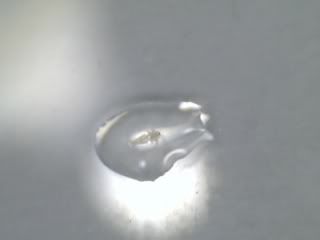
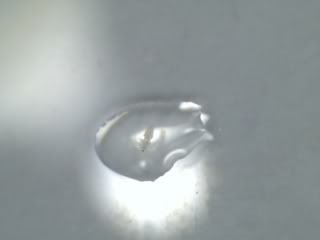 [/center]
[/center]
[center][i][b]24 hour old Fairy Shrimp nauplii[/b][/i][/center]
One observation....by comparison, the nauplii of Branchinella thailandensis are almost transparent, opaque white in colour unlike brineshrimp which are orange. I have administered a small feed (20ml) of live algae to the culture jar, just enough to tinge the water green.
[*][b]Feeding;[/b]
Fairy shrimp are filter feeders, They strain tiny particles out of the water for food, in the wild this would mean mostly bacteria, algae, and fungal spores. In captivity I feed them "Green Water" live algae which I culture myself. (details of how to culture this green soup can be found within my Daphnia pulex thread)
[center]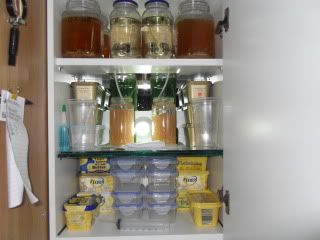
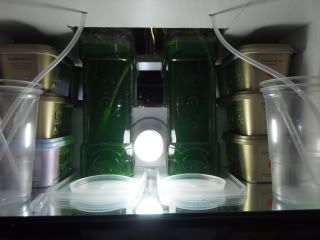 [/center]
[/center]
[center][i][b](i)My Live-Food Larder...(ii)The cultivation of Algae (possibly Chlorella sp.)[/b][/i][/center]
You can determine how much food is enough by using this rule of thumb: The water should be slightly hazy, but not cloudy. You should be able to see through it. If it becomes cloudy, stop feeding for a day or two until it clears up. If it becomes extremely clear, feed a little bit more. Increase their food as they grow. At about 2 weeks, the shrimp will need approximately 1 ml per day. When they are fully grown, they will need up to 3 mls daily.
[*][b]Growth;[/b]
Growth of fairy shrimp is pretty rapid, it has to be with such a short lifespan. They will reach adulthood when they are about 12mm long. By four weeks old, they should be close to 25mm long. On conferring with shrimp farms in the far east, they seem to recommend a density of around 15 shrimp per litre of water once they reach adulthood. Here follows a series of images cataloguing the growth of Branchinella thailandensis.
[center]
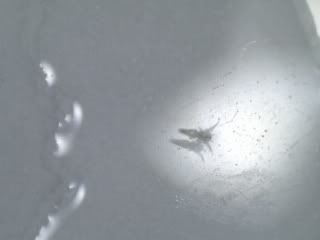 [/center]
[/center]
[center][b]24 & 48 hour nauplii in a globule of water[/b][/center]
[center]There is a notable increase in size of the nauplii today (pic2) with the gut is now green in colour which signifies they are taking on food. The body is starting to elongate and the swimming appendages have lengthened somewhat. Their swimming pattern has taken on much more of a glide rather than the jerky movements noticed when they'd just broke free from the egg casing.[/center]
[center]
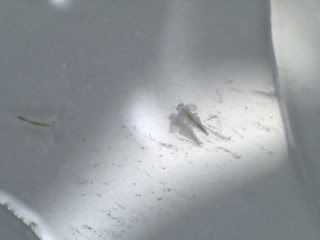 [/center]
[/center]
[center][b]3 Day Old Shrimp[/b][/center]
[center]The body of the young shrimp continue to elongate and grow. The legs/swimming appendages are more numerous and noticeable now. Swimming seems effortless as they move through the water column. Today I added 60ml of algae to the container to keep the food availability high. Things seem to be progressing nicely
[/center]
[center]
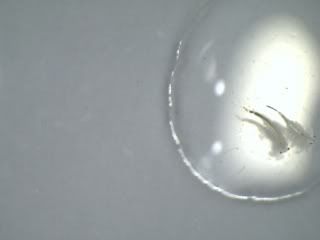 [/center]
[/center]
[center][b]A Pair of Shrimp on Day 5[/b][/center]
[center]Although still very small, the shrimp continue to feed and grow. I now perform small water-changes in the jar with a view of moving them on to larger quarters shortly. I may also add a slow bubble from an airline to keep the oxygen content up.[/center]
[center]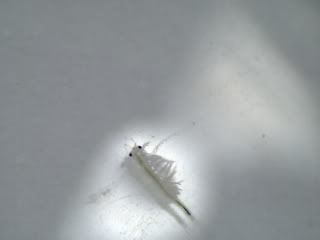
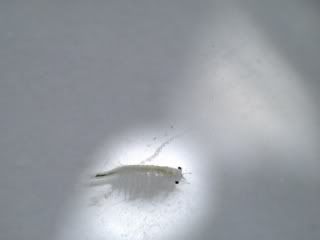 [/center]
[/center]
[center][b]Day 7[/b][/center]
[center]Again they are growing well. I have transferred all the shrimp from the glass jar to a 3ltr plastic Ice Cream tub to afford them more space. Looking closely at the split tail section, it appears that they are just starting to acquire the red pigmentation which is common in this species.[/center]
[center]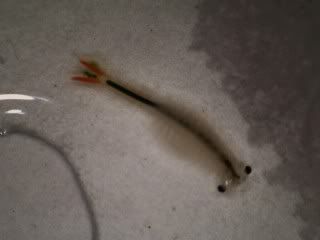
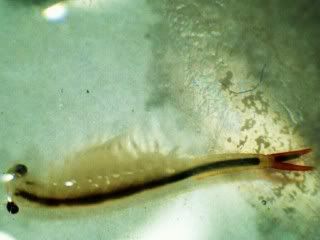 [/center]
[/center]
[center][b]The shrimp at 14 days[/b][/center]
[center]The shrimp are now growing at pace and we have now reached the 2 week stage since I wet the first batch of cysts. They are now taking on a more adult appearance and are around the 8-10mm mark in total body length. Interestingly not all the shrimp are growing at the same pace. Do males grow quicker and larger than females?[/center]
After the third week, (21 days) I again, transfer all the shrimp and contents of their original container (3lb Ice Cream carton) into larger quarters (an all glass tank 10x10x18). This allows them a much more commodious space in which to grow out. Much more live algae is being consumed than before. 200mls of the elixir is now being added which gradually is being taken up by the shrimp, this murky soup clears after 48 hours to which another dose of food is administered. Large males are starting to spar at this stage. Females are maturing and are carrying white eggs awaiting fertilisation which will darken and form a hardshell cyst after 24 hours, these cysts will subsequently be released to lay dormant on the aquarium floor ready to be harvested in another month or so.
[center]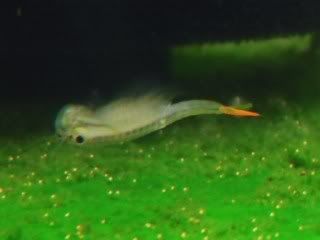
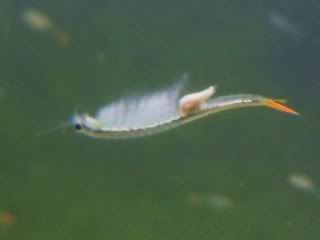 [/center]
[/center]
[center] [b]B. thailandensis one month after hatching[/b] [/center][center][i]male (left) with extended antenae, Female (right) with her egg chamber clearly visible[/i][/center]
[*][b]Reproduction;[/b]
Once the shrimp reach maturity they will concentrate exclusively on breeding . Their objective now is to fertilise a female to make new viable cysts. The females will begin to produce eggs as soon as they mature. The bright white eggs are stored in a transparent cigar shaped pouch that is attached to their abdomen. This brood pouch makes the female easy to identify. The male shrimp constantly swims around looking for a suitable female. When he finds one, he will grab her with his large antennae. The antennae look like walrus tusks attached to his face. He will quickly fertilize her eggs and swim off to find another suitable mate. You can tell when the eggs have been fertilized because they will grow larger and turn a pale tan colour as they begin to develop a cyst coating. Once the cysts are fully coated, the female will push them out of her pouch, where they will sink to the bottom of the container.
[center]
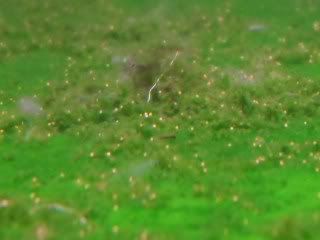 [/center]
[/center]
[center][b](i) Copulation a male and female fairy shrimp entering a fertilisation embrace. (male to the rear)
(ii) B. thailandensis cysts litter the substrate of the container[/b][/center]
The little embryos inside will grow and develop for about a day or two. When they reach the point of about 4,000 cells they will shut down and become dormant. They will not hatch until they are completely dried out, chilled and re-wetted. One point to note here is, that from published literature, which recommends that it is better to leave the cysts in the parent aquarium for around two to four weeks after all shrimp have expired which allows the resting shrimp embryo to fully develop before entering its diapause (resting) stage.
[*][b]The Next Generation;[/b]
Afer 6-8 weeks the shrimp will start to die off due to their life cycle having run its course, we should, by this time have many cysts strewn all around the floor of their container. You cannot hatch these eggs straight away. They have to be harvested, dried and refrigerated for a week or so before starting the cycle all over again.
To harvest the cysts I use a clean meat/turkey baster and suck all the gunk from the floor of the container, I then squirt this through coffee filters. One full baster full of gunk laden water to each coffee filter is ample.
[center]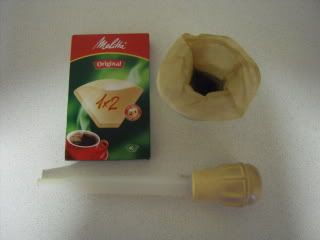
 [/center]
[/center]
[center][b](i) Collecting utensils
(ii) Freshly collected substrate from the base of the Shrimp's aquarium[/b][/center]
I open out the coffee filter fully by carefully tearing down the seam. The filter is then outspread on layers of paper hand towel to soak up the excess water. This can now be left to dry out fully on top of the aquarium cover glass.
[center]
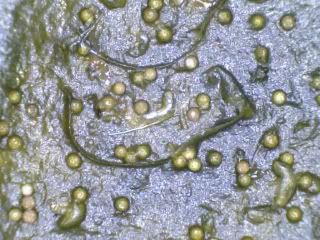 [/center]
[/center]
[center][b](i) Shrimp eggs on laid out paper towelling
(ii) Newly collected Shrimp eggs under 200x magnification [/b][/center]
Don't worry about harming the shrimp as they are safely encapsulated inside their hard cased shell. Once fully dried you can place the collected gunk into a small plastic bag and place in the fridge for around a week (this seems to yield better results for subsequent hatches). After this allotted time I can then start the process over again only this time around as with subsequent hatches I can sacrifice some of the shrimp as fish food. After a period of time the fish will reap the rewards more and more as your stock of shrimp cysts increases.
[/list]
[b]Observations;[/b]
[i]21/06/2010[/i] - Initial setting up and egg immersion
[i]30/06/2010[/i] - Not all the shrimp seem to be developing at the same rate and are maturing at different times - due to the probability that not all eggs might have been laid/hatched at the same time.
[i]10/07/2010[/i] - White eggs become apparent in brood pouches of 10mm females - Maturing males sparring.
[i]11/07/2010[/i] - Eggs within above females darken in colour (hardshell cyst formation)
[i]13/07/2010[/i] - It is noticeable that a great many eggs are strew amongst the debris on the base of the container
[i]21/07/2010[/i] - I sacrificed a medium sized shrimp today and placed it into a breeding tank containing adult Rivulus punctatus. The shrimp was taken with relish by a lucky female. I now know that the fish will eat the shrimp.
[b]Future Developments;[/b]
This project was a scratch at the surface, a tentative approach to shrimp culturing. For the future I will be using adapted upturned 15 litre water vessels, the type used on drinks dispensers within foyers of office blocks. I'm also looking into the prospect of upping my algae production by purchasing a couple of Aqua Medic Plankton Reactors (see below) and adding CO2. This I feel is both a necessity and a natural progression if I'm to feed my cultures of Daphnia pulex and Moina as well as the shrimp.
[center]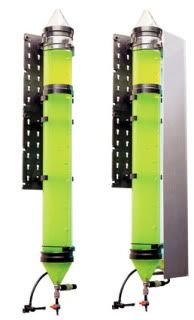 [/center]
[/center]
[center][b]Aqua-Medic Plankton Reactors[/b][/center]
[b]Conclusion;[/b]
Seeing as I'm essentially only a hobbyist dabbling in culturing certain terrestrial and aquatic live-foods this operation is diminutive as shrimp aquaculture goes, it's adequate for my present needs. I do feel however that I would get better results by scaling up to larger vessels and dedicated filtration etc. something I'm in the process of accessing.
I hope you have enjoyed this lengthy insight into the way I culture Thai Fairy Shrimp. It's a fairly easy process if certain parameters are followed. Admittedly it takes a little while to amass a decent quantity of cysts to begin feeding to the fish, but whilst you wait for this to happen you can enjoy observing the life-cycle of this truly amazing little creature.
Thanks for viewing and I hope you have enjoyed reading this detailed editorial as much as I've enjoyed compiling it.
[b]Additional Reference Material[/b]
[i]The cyst hatching pattern of the Thai Fairy Shrimp, Branchinella thailandensis Sanoamuang, Saengphan & Murugan, 2002 (Anostraca)[/i]
Regards
C
[center]

 [/center]
[/center][center][i][b]24 hour old Fairy Shrimp nauplii[/b][/i][/center]
One observation....by comparison, the nauplii of Branchinella thailandensis are almost transparent, opaque white in colour unlike brineshrimp which are orange. I have administered a small feed (20ml) of live algae to the culture jar, just enough to tinge the water green.
[*][b]Feeding;[/b]
Fairy shrimp are filter feeders, They strain tiny particles out of the water for food, in the wild this would mean mostly bacteria, algae, and fungal spores. In captivity I feed them "Green Water" live algae which I culture myself. (details of how to culture this green soup can be found within my Daphnia pulex thread)
[center]

 [/center]
[/center][center][i][b](i)My Live-Food Larder...(ii)The cultivation of Algae (possibly Chlorella sp.)[/b][/i][/center]
You can determine how much food is enough by using this rule of thumb: The water should be slightly hazy, but not cloudy. You should be able to see through it. If it becomes cloudy, stop feeding for a day or two until it clears up. If it becomes extremely clear, feed a little bit more. Increase their food as they grow. At about 2 weeks, the shrimp will need approximately 1 ml per day. When they are fully grown, they will need up to 3 mls daily.
[*][b]Growth;[/b]
Growth of fairy shrimp is pretty rapid, it has to be with such a short lifespan. They will reach adulthood when they are about 12mm long. By four weeks old, they should be close to 25mm long. On conferring with shrimp farms in the far east, they seem to recommend a density of around 15 shrimp per litre of water once they reach adulthood. Here follows a series of images cataloguing the growth of Branchinella thailandensis.
[center]

 [/center]
[/center][center][b]24 & 48 hour nauplii in a globule of water[/b][/center]
[center]There is a notable increase in size of the nauplii today (pic2) with the gut is now green in colour which signifies they are taking on food. The body is starting to elongate and the swimming appendages have lengthened somewhat. Their swimming pattern has taken on much more of a glide rather than the jerky movements noticed when they'd just broke free from the egg casing.[/center]
[center]

 [/center]
[/center][center][b]3 Day Old Shrimp[/b][/center]
[center]The body of the young shrimp continue to elongate and grow. The legs/swimming appendages are more numerous and noticeable now. Swimming seems effortless as they move through the water column. Today I added 60ml of algae to the container to keep the food availability high. Things seem to be progressing nicely
[/center]
[center]

 [/center]
[/center][center][b]A Pair of Shrimp on Day 5[/b][/center]
[center]Although still very small, the shrimp continue to feed and grow. I now perform small water-changes in the jar with a view of moving them on to larger quarters shortly. I may also add a slow bubble from an airline to keep the oxygen content up.[/center]
[center]

 [/center]
[/center][center][b]Day 7[/b][/center]
[center]Again they are growing well. I have transferred all the shrimp from the glass jar to a 3ltr plastic Ice Cream tub to afford them more space. Looking closely at the split tail section, it appears that they are just starting to acquire the red pigmentation which is common in this species.[/center]
[center]

 [/center]
[/center][center][b]The shrimp at 14 days[/b][/center]
[center]The shrimp are now growing at pace and we have now reached the 2 week stage since I wet the first batch of cysts. They are now taking on a more adult appearance and are around the 8-10mm mark in total body length. Interestingly not all the shrimp are growing at the same pace. Do males grow quicker and larger than females?[/center]
After the third week, (21 days) I again, transfer all the shrimp and contents of their original container (3lb Ice Cream carton) into larger quarters (an all glass tank 10x10x18). This allows them a much more commodious space in which to grow out. Much more live algae is being consumed than before. 200mls of the elixir is now being added which gradually is being taken up by the shrimp, this murky soup clears after 48 hours to which another dose of food is administered. Large males are starting to spar at this stage. Females are maturing and are carrying white eggs awaiting fertilisation which will darken and form a hardshell cyst after 24 hours, these cysts will subsequently be released to lay dormant on the aquarium floor ready to be harvested in another month or so.
[center]

 [/center]
[/center][center] [b]B. thailandensis one month after hatching[/b] [/center][center][i]male (left) with extended antenae, Female (right) with her egg chamber clearly visible[/i][/center]
[*][b]Reproduction;[/b]
Once the shrimp reach maturity they will concentrate exclusively on breeding . Their objective now is to fertilise a female to make new viable cysts. The females will begin to produce eggs as soon as they mature. The bright white eggs are stored in a transparent cigar shaped pouch that is attached to their abdomen. This brood pouch makes the female easy to identify. The male shrimp constantly swims around looking for a suitable female. When he finds one, he will grab her with his large antennae. The antennae look like walrus tusks attached to his face. He will quickly fertilize her eggs and swim off to find another suitable mate. You can tell when the eggs have been fertilized because they will grow larger and turn a pale tan colour as they begin to develop a cyst coating. Once the cysts are fully coated, the female will push them out of her pouch, where they will sink to the bottom of the container.
[center]

 [/center]
[/center][center][b](i) Copulation a male and female fairy shrimp entering a fertilisation embrace. (male to the rear)
(ii) B. thailandensis cysts litter the substrate of the container[/b][/center]
The little embryos inside will grow and develop for about a day or two. When they reach the point of about 4,000 cells they will shut down and become dormant. They will not hatch until they are completely dried out, chilled and re-wetted. One point to note here is, that from published literature, which recommends that it is better to leave the cysts in the parent aquarium for around two to four weeks after all shrimp have expired which allows the resting shrimp embryo to fully develop before entering its diapause (resting) stage.
[*][b]The Next Generation;[/b]
Afer 6-8 weeks the shrimp will start to die off due to their life cycle having run its course, we should, by this time have many cysts strewn all around the floor of their container. You cannot hatch these eggs straight away. They have to be harvested, dried and refrigerated for a week or so before starting the cycle all over again.
To harvest the cysts I use a clean meat/turkey baster and suck all the gunk from the floor of the container, I then squirt this through coffee filters. One full baster full of gunk laden water to each coffee filter is ample.
[center]

 [/center]
[/center][center][b](i) Collecting utensils
(ii) Freshly collected substrate from the base of the Shrimp's aquarium[/b][/center]
I open out the coffee filter fully by carefully tearing down the seam. The filter is then outspread on layers of paper hand towel to soak up the excess water. This can now be left to dry out fully on top of the aquarium cover glass.
[center]

 [/center]
[/center][center][b](i) Shrimp eggs on laid out paper towelling
(ii) Newly collected Shrimp eggs under 200x magnification [/b][/center]
Don't worry about harming the shrimp as they are safely encapsulated inside their hard cased shell. Once fully dried you can place the collected gunk into a small plastic bag and place in the fridge for around a week (this seems to yield better results for subsequent hatches). After this allotted time I can then start the process over again only this time around as with subsequent hatches I can sacrifice some of the shrimp as fish food. After a period of time the fish will reap the rewards more and more as your stock of shrimp cysts increases.
[/list]
[b]Observations;[/b]
[i]21/06/2010[/i] - Initial setting up and egg immersion
[i]30/06/2010[/i] - Not all the shrimp seem to be developing at the same rate and are maturing at different times - due to the probability that not all eggs might have been laid/hatched at the same time.
[i]10/07/2010[/i] - White eggs become apparent in brood pouches of 10mm females - Maturing males sparring.
[i]11/07/2010[/i] - Eggs within above females darken in colour (hardshell cyst formation)
[i]13/07/2010[/i] - It is noticeable that a great many eggs are strew amongst the debris on the base of the container
[i]21/07/2010[/i] - I sacrificed a medium sized shrimp today and placed it into a breeding tank containing adult Rivulus punctatus. The shrimp was taken with relish by a lucky female. I now know that the fish will eat the shrimp.
[b]Future Developments;[/b]
This project was a scratch at the surface, a tentative approach to shrimp culturing. For the future I will be using adapted upturned 15 litre water vessels, the type used on drinks dispensers within foyers of office blocks. I'm also looking into the prospect of upping my algae production by purchasing a couple of Aqua Medic Plankton Reactors (see below) and adding CO2. This I feel is both a necessity and a natural progression if I'm to feed my cultures of Daphnia pulex and Moina as well as the shrimp.
[center]
 [/center]
[/center][center][b]Aqua-Medic Plankton Reactors[/b][/center]
[b]Conclusion;[/b]
Seeing as I'm essentially only a hobbyist dabbling in culturing certain terrestrial and aquatic live-foods this operation is diminutive as shrimp aquaculture goes, it's adequate for my present needs. I do feel however that I would get better results by scaling up to larger vessels and dedicated filtration etc. something I'm in the process of accessing.
I hope you have enjoyed this lengthy insight into the way I culture Thai Fairy Shrimp. It's a fairly easy process if certain parameters are followed. Admittedly it takes a little while to amass a decent quantity of cysts to begin feeding to the fish, but whilst you wait for this to happen you can enjoy observing the life-cycle of this truly amazing little creature.
Thanks for viewing and I hope you have enjoyed reading this detailed editorial as much as I've enjoyed compiling it.
[b]Additional Reference Material[/b]
[i]The cyst hatching pattern of the Thai Fairy Shrimp, Branchinella thailandensis Sanoamuang, Saengphan & Murugan, 2002 (Anostraca)[/i]
Regards
C
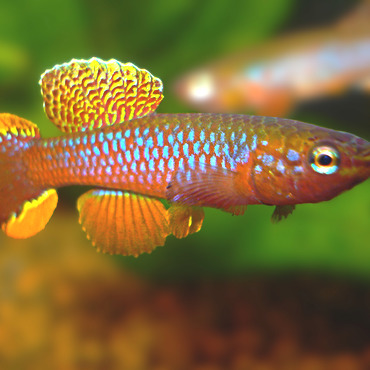
Le 25 avril 2011 à 13h09

Pascal L. [Exteval]
Le 25 avril 2011 à 13h09
Vraiment, super intéressant :)
Je me suis essayé à ces crevettes et j'ai échoué, je comprend un peu mieux pourquoi maintenant.
Ce que je trouve le plus contraignant, c'est la production d'algues pour nourrir tout cela, j'ai déjà du mal à conserver une souche de paramécie en les nourrissant avec du lait en poudre alors avec des algues en batterie dans un réacteur...
Je me suis essayé à ces crevettes et j'ai échoué, je comprend un peu mieux pourquoi maintenant.
Ce que je trouve le plus contraignant, c'est la production d'algues pour nourrir tout cela, j'ai déjà du mal à conserver une souche de paramécie en les nourrissant avec du lait en poudre alors avec des algues en batterie dans un réacteur...

Le 25 avril 2011 à 13h29

BigC
Le 25 avril 2011 à 13h29
Salut Pascal,
Dont utiliser votre méthode normale pour la culture de la paramécie. je vais plutôt mettre une thread peu sur la façon dont je le fais, il est 100% idiot proof et vous serez étonné par les résultats.
Si vous souhaitez une culture de départ, je ne seraient que trop heureux de vous en fournir un.
s'il vous plaît envoyez-moi votre adresse
http://www.killiclubdefrance.org/forum/index.php?topic=5241.0
La production d'algues est aussi simple si vous suivez le fil "Forty Shades of Green"
Les algues peuvent être utilisées pour alimenter en eau des cultures peut naître sans parler des alevins de certaines espèces
so it's good to have this as the start of a food chain
Je crois que si vous allez à des choses telles que la culture puce d'eau et / ou des crevettes dont vous avez besoin d'avoir une sorte de chaîne alimentaire naturelle en place, de cette façon vous vous donnez une meilleure chance de succès. Comme je l'ai mentionné avant, j'ai essayé de Daphnia sur la levure et j'ai obtenu des résultats raisonnables (mais pas bon) J'ai aussi essayé cette espèce de crevette d'eau douce et si vous nourrissez de levure à la crevette de cette baisse en nombre assez rapidement.
J'exhorte donc les gens à essayer et les algues de culture à un moment donné, il ouvre beaucoup de portes quand les créatures de culture tels que les daphnies et crevettes
Regards
Colin
Dont utiliser votre méthode normale pour la culture de la paramécie. je vais plutôt mettre une thread peu sur la façon dont je le fais, il est 100% idiot proof et vous serez étonné par les résultats.
Si vous souhaitez une culture de départ, je ne seraient que trop heureux de vous en fournir un.
s'il vous plaît envoyez-moi votre adresse
http://www.killiclubdefrance.org/forum/index.php?topic=5241.0
La production d'algues est aussi simple si vous suivez le fil "Forty Shades of Green"
Les algues peuvent être utilisées pour alimenter en eau des cultures peut naître sans parler des alevins de certaines espèces
so it's good to have this as the start of a food chain
Je crois que si vous allez à des choses telles que la culture puce d'eau et / ou des crevettes dont vous avez besoin d'avoir une sorte de chaîne alimentaire naturelle en place, de cette façon vous vous donnez une meilleure chance de succès. Comme je l'ai mentionné avant, j'ai essayé de Daphnia sur la levure et j'ai obtenu des résultats raisonnables (mais pas bon) J'ai aussi essayé cette espèce de crevette d'eau douce et si vous nourrissez de levure à la crevette de cette baisse en nombre assez rapidement.
J'exhorte donc les gens à essayer et les algues de culture à un moment donné, il ouvre beaucoup de portes quand les créatures de culture tels que les daphnies et crevettes
Regards
Colin

Le 25 avril 2011 à 16h42

Pascal L. [Exteval]
Le 25 avril 2011 à 16h42
Vivant à la campagne, j'ai abandonné toutes cultures de bestioles (Sauf les paramécies)
J'achète des vers de vase régulièrement (C'est la base de la nourriture de mes poissons) et je vais pêcher régulièrement des daphnies et des cyclopes en abondance dans un étang à proximité de chez moi. Quand ça marche bien, en 5mn je récolte plus d'un kilo de daphnies...
J'achète des vers de vase régulièrement (C'est la base de la nourriture de mes poissons) et je vais pêcher régulièrement des daphnies et des cyclopes en abondance dans un étang à proximité de chez moi. Quand ça marche bien, en 5mn je récolte plus d'un kilo de daphnies...

Le 25 avril 2011 à 18h35

BigC
Le 25 avril 2011 à 18h35
:D
Vous êtes toujours autant de chance Pascal, je sais où aller chercher de nombreux Daphnia mais je voulais à la culture d'une souche vrai D. pulex sans tous les Cyclopes, etc que vous pouvez ramasser dans la nature. Irlande du Nord est très mauvais pour les magasins aquariophile bonne et ils ne vendent même livefood. son dur pour moi de mettre la main sur de la nourriture, sauf si je sors de recherche de nourriture. J'avais l'habitude de recueillir des Tubifex, localement, et le purger, mais ils ont fermé l'usine de filtration où je l'ai recueillie.
Par conséquent, j'ai à la culture plus de ce que j'ai à la maison. en plus c'est très intéressant quand vous échouez et continuer à essayer jusqu'à ce que vous obtenez quelque chose de bien.
Je voudrais être en mesure d'acheter des tubifex vivants
Cordialement
Colin
Vous êtes toujours autant de chance Pascal, je sais où aller chercher de nombreux Daphnia mais je voulais à la culture d'une souche vrai D. pulex sans tous les Cyclopes, etc que vous pouvez ramasser dans la nature. Irlande du Nord est très mauvais pour les magasins aquariophile bonne et ils ne vendent même livefood. son dur pour moi de mettre la main sur de la nourriture, sauf si je sors de recherche de nourriture. J'avais l'habitude de recueillir des Tubifex, localement, et le purger, mais ils ont fermé l'usine de filtration où je l'ai recueillie.
Par conséquent, j'ai à la culture plus de ce que j'ai à la maison. en plus c'est très intéressant quand vous échouez et continuer à essayer jusqu'à ce que vous obtenez quelque chose de bien.
Je voudrais être en mesure d'acheter des tubifex vivants
Cordialement
Colin

Le 26 avril 2011 à 21h08

Nikho
Le 26 avril 2011 à 21h08
Voila le copier/coller de la traduction google sans corrections... partie 2
21/06/2010 Le premier lot d'oeufs sont prêts et préparés pour éclore que par les images ci-dessus. lots 24 heures plus tard, comme prévu, la première crevette ont éclos, d'entre eux, ils ressemblent nauplii d'Artemia avec des motifs de natation à peu près identique. Mon petit microscope 200x n'est tout simplement pas tout à fait à la tâche à ces stades précoces de la vie, mais devrait entrer en son propre dans les jours à venir.
24 heures vieille fée crevettes nauplii
Une observation .... par comparaison, les nauplii de thailandensis Branchinella sont presque transparent, opaque de couleur blanche contrairement brineshrimp qui sont orange. J'ai administré une alimentation de petite taille (20 ml) d'algues vivent dans le pot de culture, juste assez pour teinte vert d'eau.
* Alimentation;
Fairy crevettes sont des filtreurs, ils souche de minuscules particules de l'eau pour l'alimentation, à l'état sauvage, cela signifierait essentiellement des bactéries, des algues, et les spores fongiques. En captivité, je les nourrir "l'eau verte" algues vivantes que j'ai moi-même la culture. (Détails sur la façon de la culture de cette soupe verte peut être trouvé dans mon fil Daphnia pulex)
(I) Mon Live-alimentaire ... Larder (ii) la culture d'algues (Chlorella sp éventuellement.)
Vous pouvez déterminer la quantité de nourriture suffisante en utilisant cette règle de base: L'eau devrait être légèrement voilé, mais pas clair. Vous devriez être en mesure de voir à travers. Si elle devient trouble, cesser de se nourrir pendant un jour ou deux, jusqu'à ce qu'elle ne disparaisse. Si elle devient très clair, nourrir un peu plus. Augmenter leur nourriture à mesure qu'ils grandissent. À environ deux semaines, les crevettes auront besoin d'environ 1 ml par jour. Quand ils sont adultes, ils auront besoin jusqu'à 3 ml par jour.
* Croissance;
La croissance de la crevette de fée est assez rapide, il doit être avec une telle durée de vie courte. Ils atteindront l'âge adulte quand ils sont environ 12 mm de long. En quatre semaines, ils devraient être près de 25 mm de long. Sur l'attribution des fermes de crevettes dans l'Extrême-Orient, ils semblent recommander une densité d'environ 15 crevettes par litre d'eau une fois qu'ils atteignent l'âge adulte. Voici une série d'images de catalogage de la croissance de thailandensis Branchinella.
24 & 48 nauplii heure dans un globule de l'eau
Il ya une augmentation notable de la taille des nauplii d'aujourd'hui (photo2) avec l'intestin est maintenant de couleur verte qui signifie qu'ils prennent sur les denrées alimentaires. Le corps commence à s'allonger et les appendices de natation se sont allongés un peu. Leur modèle de natation a pris beaucoup plus de finesse plutôt que les mouvements saccadés remarqué quand on venait se sont libérés de l'enveloppe des oeufs.
Jour 3 crevettes Vieux
Le corps de la crevette jeunes continuent à s'allonger et à grandir. Les jambes / appendices natatoires sont plus nombreux et plus visibles aujourd'hui. Natation semble sans effort qui se déplacent dans la colonne d'eau. Aujourd'hui, j'ai ajouté 60 ml d'algues sur le conteneur à maintenir la disponibilité des denrées alimentaires. Les choses semblent évoluer normalement
Une paire de crevettes sur 5 jours
Bien qu'il soit encore très faible, les crevettes continuent de se nourrir et croître. Je vais maintenant effectuer des petits changements à l'eau dans le pot en vue de les déplacer sur de plus grands locaux peu de temps. Je peux également ajouter une bulle de ralentir à une entreprise de garder la teneur en oxygène vers le haut.
Jour 7
Encore une fois qu'ils grandissent bien. J'ai transféré tous les crevettes dans le bocal de verre pour un bain de glace 3 litres en plastique à la crème pour leur donner plus d'espace. En regardant de près à la section de la queue divisée, il semble qu'ils commencent à peine à acquérir la pigmentation rouge qui est fréquent dans cette espèce.
La crevette à 14 jours
Les crevettes sont maintenant de plus en plus au rythme et nous avons maintenant atteint le stade 2 semaines depuis que j'ai mouillé le premier lot de kystes. Elles prennent désormais un aspect plus adulte et sont autour de la marque de 8-10mm de longueur totale du corps. Il est intéressant de ne pas toutes les crevettes sont de plus en plus au même rythme. Ne les mâles grandissent plus vite et plus gros que les femelles?
Après la troisième semaine, (21 jours) j'ai de nouveau, le transfert de toutes les crevettes et le contenu de leur contenant d'origine (£ 3 Ice Cream carton) dans des locaux plus grands (un réservoir de verre tous les 10x10x18). Cela leur permet un espace beaucoup plus commode dans lequel de croître. Une grande partie des algues et plus vivent est consommée que par le passé. 200mls de l'élixir est maintenant ajoutée qui est progressivement repris par la crevette, cette soupe troubles disparaissent après 48 heures à laquelle une autre dose de nourriture est administré. Les grands mâles commencent à espar à ce stade. Les femelles arrivent à maturité et sont porteuses d'œufs blancs attendant la fécondation qui va s'assombrir et former un kyste rigide après 24 heures, ces kystes sera ensuite publié au dormaient sur le plancher d'aquarium prêt à être récolté dans un mois ou deux.
* La reproduction;
Une fois la maturité atteindre crevettes qu'ils se concentrera exclusivement sur l'élevage. Leur objectif est maintenant de féconder une femelle de faire de nouveaux kystes viables. Les femelles commencent à produire des oeufs dès qu'ils matures. Les oeufs sont blanc lumineux placés dans un sachet transparent en forme de cigare qui est attaché à l'abdomen. Cette poche incubatrice fait la femelle faciles à identifier. La crevette mâle nage sans cesse autour de la recherche d'une femme convenable. Quand il en trouve un, il va l'attraper avec ses grandes antennes. Le regard antennes, comme des défenses de morse attaché à son visage. Il va vite féconder ses œufs et de se baigner à trouver un autre compagnon approprié. Vous pouvez dire quand les œufs ont été fécondés, car ils grossissent et prennent une couleur ocre pâle comme ils commencent à développer un revêtement kyste. Une fois que les kystes sont entièrement revêtus, la femelle va les pousser hors de sa poche, où ils se déposent au fond du récipient.
Les embryons peu à l'intérieur grandira et se développera pendant environ un jour ou deux. Quand ils atteignent le point de l'ordre de 4.000 cellules qu'ils seront fermées et entrent en dormance. Ils ne seront pas trappe jusqu'à ce qu'ils soient complètement séché, réfrigérés et re-mouillé. Un point à noter ici, c'est que de la littérature publiée, qui recommande qu'il est préférable de laisser les kystes dans l'aquarium parent pendant environ deux à quatre semaines après que toutes les crevettes ont expiré qui permet à l'embryon de la crevette de repos pour développer pleinement avant d'entrer dans sa diapause (au repos) stade.
* La prochaine génération;
Apres 6-8 semaines la crevette va commencer à mourir en raison de leur cycle de vie ayant suivi son cours, nous devrions, à cette époque, ont de nombreux kystes éparpillés sur le sol de leur contenant. Vous ne pouvez pas éclore ces oeufs tout de suite. Ils doivent être récoltées, séchées puis réfrigérer pendant une semaine ou deux avant de commencer le cycle de nouveau.
Pour récolter les kystes-je utiliser une viande propre / poire à jus et sucer toute la crasse du fond du conteneur, je puis squirt ce à travers des filtres à café. Une poire à plein de l'eau chargée de crasse à chaque filtre à café est ample.
J'ouvre le filtre à café entièrement par attentivement la démolition de la couture. Le filtre est ensuite déployées sur des couches de serviettes en papier pour absorber l'excès d'eau. Cela peut maintenant être laissée à sécher complètement sur le dessus du couvercle en verre aquarium.
Ne vous inquiétez pas nuire à la crevette comme ils sont en toute sécurité encapsulé dans leur coquille dure à gaine. Une fois complètement sèche, vous pouvez placer la crasse recueillies dans un petit sac en plastique et placez au réfrigérateur pendant environ une semaine (ce qui semble donner de meilleurs résultats pour les écoutilles ultérieure). Après ce temps imparti je peux alors recommencer le processus à nouveau que cette fois-ci comme avec les trappes ont suivi, j'ai peut sacrifier une partie de la crevette comme aliment pour poisson. Après une période de temps que les poissons pourront récolter les fruits de plus en plus que votre stock de crevettes augmente kystes.
Observations;
21/06/2010 - Le réglage initial et d'immersion oeuf
30/06/2010 - ne sont pas toutes les crevettes semblent se développer au même rythme et sont à échéance à différents moments - en raison de la probabilité que tous les œufs auraient été portées / éclos en même temps.
10/07/2010 - oeufs White apparaîtront dans des sachets couvée de 10mm femmes - hommes Elevage sparring.
07/11/2010 - Les œufs des femelles ci-dessus prennent une couleur foncée (la formation de kystes rigide)
13/07/2010 - Il est à noter qu'un grand nombre d'oeufs sont parmi les débris jonchent le fond du récipient
21/07/2010 - j'ai sacrifié une crevette de taille moyenne d'aujourd'hui et l'a placé dans une cuve contenant la reproduction des adultes Rivulus punctatus. La crevette a été prise avec goût par une femme chanceuse. Je sais maintenant que les poissons mangent les crevettes.
Les développements futurs;
Ce projet a été une éraflure à la surface, une approche expérimentale à la crevette culture. Pour l'avenir, je vais utiliser adaptés renversé 15 navires litre d'eau, du type utilisé sur les distributeurs de boissons dans les foyers des immeubles de bureaux. Je cherche aussi dans la perspective de faire monter ma production d'algues en achetant un couple de réacteurs Aqua Medic plancton (voir ci-dessous) et l'ajout de CO2. Ce que je ressens est une nécessité et une progression naturelle si je suis pour nourrir mes cultures de Daphnia pulex et Moina ainsi que les crevettes.
Réacteurs plancton Aqua-Medic
Conclusion;
Car je suis seulement un amateur essentiellement barboter dans la culture de certaines terrestres et aquatiques vivent-foods cette opération est diminutif que l'aquaculture de crevettes va, c'est suffisant pour mes besoins actuels. Je me sens cependant que je obtenir de meilleurs résultats en intensifiant les plus grands navires et dédié quelque chose etc filtration je suis dans le processus d'accès.
J'espère que vous avez apprécié cet aperçu longues dans la façon dont je la culture thaïlandaise Fairy crevettes. C'est un processus assez facile si certains paramètres sont suivis. Certes, il prend un peu de temps pour amasser une quantité décente de kystes commencent à se nourrir les poissons, mais pendant que vous attendez pour cela vous pouvez profiter de l'observation du cycle de vie de cette créature vraiment incroyable petite.
Merci pour le visionnement et j'espère que vous avez apprécié la lecture de cet éditorial détaillée autant que j'ai apprécié le compiler.
21/06/2010 Le premier lot d'oeufs sont prêts et préparés pour éclore que par les images ci-dessus. lots 24 heures plus tard, comme prévu, la première crevette ont éclos, d'entre eux, ils ressemblent nauplii d'Artemia avec des motifs de natation à peu près identique. Mon petit microscope 200x n'est tout simplement pas tout à fait à la tâche à ces stades précoces de la vie, mais devrait entrer en son propre dans les jours à venir.
24 heures vieille fée crevettes nauplii
Une observation .... par comparaison, les nauplii de thailandensis Branchinella sont presque transparent, opaque de couleur blanche contrairement brineshrimp qui sont orange. J'ai administré une alimentation de petite taille (20 ml) d'algues vivent dans le pot de culture, juste assez pour teinte vert d'eau.
* Alimentation;
Fairy crevettes sont des filtreurs, ils souche de minuscules particules de l'eau pour l'alimentation, à l'état sauvage, cela signifierait essentiellement des bactéries, des algues, et les spores fongiques. En captivité, je les nourrir "l'eau verte" algues vivantes que j'ai moi-même la culture. (Détails sur la façon de la culture de cette soupe verte peut être trouvé dans mon fil Daphnia pulex)
(I) Mon Live-alimentaire ... Larder (ii) la culture d'algues (Chlorella sp éventuellement.)
Vous pouvez déterminer la quantité de nourriture suffisante en utilisant cette règle de base: L'eau devrait être légèrement voilé, mais pas clair. Vous devriez être en mesure de voir à travers. Si elle devient trouble, cesser de se nourrir pendant un jour ou deux, jusqu'à ce qu'elle ne disparaisse. Si elle devient très clair, nourrir un peu plus. Augmenter leur nourriture à mesure qu'ils grandissent. À environ deux semaines, les crevettes auront besoin d'environ 1 ml par jour. Quand ils sont adultes, ils auront besoin jusqu'à 3 ml par jour.
* Croissance;
La croissance de la crevette de fée est assez rapide, il doit être avec une telle durée de vie courte. Ils atteindront l'âge adulte quand ils sont environ 12 mm de long. En quatre semaines, ils devraient être près de 25 mm de long. Sur l'attribution des fermes de crevettes dans l'Extrême-Orient, ils semblent recommander une densité d'environ 15 crevettes par litre d'eau une fois qu'ils atteignent l'âge adulte. Voici une série d'images de catalogage de la croissance de thailandensis Branchinella.
24 & 48 nauplii heure dans un globule de l'eau
Il ya une augmentation notable de la taille des nauplii d'aujourd'hui (photo2) avec l'intestin est maintenant de couleur verte qui signifie qu'ils prennent sur les denrées alimentaires. Le corps commence à s'allonger et les appendices de natation se sont allongés un peu. Leur modèle de natation a pris beaucoup plus de finesse plutôt que les mouvements saccadés remarqué quand on venait se sont libérés de l'enveloppe des oeufs.
Jour 3 crevettes Vieux
Le corps de la crevette jeunes continuent à s'allonger et à grandir. Les jambes / appendices natatoires sont plus nombreux et plus visibles aujourd'hui. Natation semble sans effort qui se déplacent dans la colonne d'eau. Aujourd'hui, j'ai ajouté 60 ml d'algues sur le conteneur à maintenir la disponibilité des denrées alimentaires. Les choses semblent évoluer normalement
Une paire de crevettes sur 5 jours
Bien qu'il soit encore très faible, les crevettes continuent de se nourrir et croître. Je vais maintenant effectuer des petits changements à l'eau dans le pot en vue de les déplacer sur de plus grands locaux peu de temps. Je peux également ajouter une bulle de ralentir à une entreprise de garder la teneur en oxygène vers le haut.
Jour 7
Encore une fois qu'ils grandissent bien. J'ai transféré tous les crevettes dans le bocal de verre pour un bain de glace 3 litres en plastique à la crème pour leur donner plus d'espace. En regardant de près à la section de la queue divisée, il semble qu'ils commencent à peine à acquérir la pigmentation rouge qui est fréquent dans cette espèce.
La crevette à 14 jours
Les crevettes sont maintenant de plus en plus au rythme et nous avons maintenant atteint le stade 2 semaines depuis que j'ai mouillé le premier lot de kystes. Elles prennent désormais un aspect plus adulte et sont autour de la marque de 8-10mm de longueur totale du corps. Il est intéressant de ne pas toutes les crevettes sont de plus en plus au même rythme. Ne les mâles grandissent plus vite et plus gros que les femelles?
Après la troisième semaine, (21 jours) j'ai de nouveau, le transfert de toutes les crevettes et le contenu de leur contenant d'origine (£ 3 Ice Cream carton) dans des locaux plus grands (un réservoir de verre tous les 10x10x18). Cela leur permet un espace beaucoup plus commode dans lequel de croître. Une grande partie des algues et plus vivent est consommée que par le passé. 200mls de l'élixir est maintenant ajoutée qui est progressivement repris par la crevette, cette soupe troubles disparaissent après 48 heures à laquelle une autre dose de nourriture est administré. Les grands mâles commencent à espar à ce stade. Les femelles arrivent à maturité et sont porteuses d'œufs blancs attendant la fécondation qui va s'assombrir et former un kyste rigide après 24 heures, ces kystes sera ensuite publié au dormaient sur le plancher d'aquarium prêt à être récolté dans un mois ou deux.
* La reproduction;
Une fois la maturité atteindre crevettes qu'ils se concentrera exclusivement sur l'élevage. Leur objectif est maintenant de féconder une femelle de faire de nouveaux kystes viables. Les femelles commencent à produire des oeufs dès qu'ils matures. Les oeufs sont blanc lumineux placés dans un sachet transparent en forme de cigare qui est attaché à l'abdomen. Cette poche incubatrice fait la femelle faciles à identifier. La crevette mâle nage sans cesse autour de la recherche d'une femme convenable. Quand il en trouve un, il va l'attraper avec ses grandes antennes. Le regard antennes, comme des défenses de morse attaché à son visage. Il va vite féconder ses œufs et de se baigner à trouver un autre compagnon approprié. Vous pouvez dire quand les œufs ont été fécondés, car ils grossissent et prennent une couleur ocre pâle comme ils commencent à développer un revêtement kyste. Une fois que les kystes sont entièrement revêtus, la femelle va les pousser hors de sa poche, où ils se déposent au fond du récipient.
Les embryons peu à l'intérieur grandira et se développera pendant environ un jour ou deux. Quand ils atteignent le point de l'ordre de 4.000 cellules qu'ils seront fermées et entrent en dormance. Ils ne seront pas trappe jusqu'à ce qu'ils soient complètement séché, réfrigérés et re-mouillé. Un point à noter ici, c'est que de la littérature publiée, qui recommande qu'il est préférable de laisser les kystes dans l'aquarium parent pendant environ deux à quatre semaines après que toutes les crevettes ont expiré qui permet à l'embryon de la crevette de repos pour développer pleinement avant d'entrer dans sa diapause (au repos) stade.
* La prochaine génération;
Apres 6-8 semaines la crevette va commencer à mourir en raison de leur cycle de vie ayant suivi son cours, nous devrions, à cette époque, ont de nombreux kystes éparpillés sur le sol de leur contenant. Vous ne pouvez pas éclore ces oeufs tout de suite. Ils doivent être récoltées, séchées puis réfrigérer pendant une semaine ou deux avant de commencer le cycle de nouveau.
Pour récolter les kystes-je utiliser une viande propre / poire à jus et sucer toute la crasse du fond du conteneur, je puis squirt ce à travers des filtres à café. Une poire à plein de l'eau chargée de crasse à chaque filtre à café est ample.
J'ouvre le filtre à café entièrement par attentivement la démolition de la couture. Le filtre est ensuite déployées sur des couches de serviettes en papier pour absorber l'excès d'eau. Cela peut maintenant être laissée à sécher complètement sur le dessus du couvercle en verre aquarium.
Ne vous inquiétez pas nuire à la crevette comme ils sont en toute sécurité encapsulé dans leur coquille dure à gaine. Une fois complètement sèche, vous pouvez placer la crasse recueillies dans un petit sac en plastique et placez au réfrigérateur pendant environ une semaine (ce qui semble donner de meilleurs résultats pour les écoutilles ultérieure). Après ce temps imparti je peux alors recommencer le processus à nouveau que cette fois-ci comme avec les trappes ont suivi, j'ai peut sacrifier une partie de la crevette comme aliment pour poisson. Après une période de temps que les poissons pourront récolter les fruits de plus en plus que votre stock de crevettes augmente kystes.
Observations;
21/06/2010 - Le réglage initial et d'immersion oeuf
30/06/2010 - ne sont pas toutes les crevettes semblent se développer au même rythme et sont à échéance à différents moments - en raison de la probabilité que tous les œufs auraient été portées / éclos en même temps.
10/07/2010 - oeufs White apparaîtront dans des sachets couvée de 10mm femmes - hommes Elevage sparring.
07/11/2010 - Les œufs des femelles ci-dessus prennent une couleur foncée (la formation de kystes rigide)
13/07/2010 - Il est à noter qu'un grand nombre d'oeufs sont parmi les débris jonchent le fond du récipient
21/07/2010 - j'ai sacrifié une crevette de taille moyenne d'aujourd'hui et l'a placé dans une cuve contenant la reproduction des adultes Rivulus punctatus. La crevette a été prise avec goût par une femme chanceuse. Je sais maintenant que les poissons mangent les crevettes.
Les développements futurs;
Ce projet a été une éraflure à la surface, une approche expérimentale à la crevette culture. Pour l'avenir, je vais utiliser adaptés renversé 15 navires litre d'eau, du type utilisé sur les distributeurs de boissons dans les foyers des immeubles de bureaux. Je cherche aussi dans la perspective de faire monter ma production d'algues en achetant un couple de réacteurs Aqua Medic plancton (voir ci-dessous) et l'ajout de CO2. Ce que je ressens est une nécessité et une progression naturelle si je suis pour nourrir mes cultures de Daphnia pulex et Moina ainsi que les crevettes.
Réacteurs plancton Aqua-Medic
Conclusion;
Car je suis seulement un amateur essentiellement barboter dans la culture de certaines terrestres et aquatiques vivent-foods cette opération est diminutif que l'aquaculture de crevettes va, c'est suffisant pour mes besoins actuels. Je me sens cependant que je obtenir de meilleurs résultats en intensifiant les plus grands navires et dédié quelque chose etc filtration je suis dans le processus d'accès.
J'espère que vous avez apprécié cet aperçu longues dans la façon dont je la culture thaïlandaise Fairy crevettes. C'est un processus assez facile si certains paramètres sont suivis. Certes, il prend un peu de temps pour amasser une quantité décente de kystes commencent à se nourrir les poissons, mais pendant que vous attendez pour cela vous pouvez profiter de l'observation du cycle de vie de cette créature vraiment incroyable petite.
Merci pour le visionnement et j'espère que vous avez apprécié la lecture de cet éditorial détaillée autant que j'ai apprécié le compiler.

Le 26 avril 2011 à 21h24

dreamer
Le 26 avril 2011 à 21h24
extrêmement intéressant, merci
le gros avantage, à mon avis, c'est qu'il s'agit d'une culture en eau douce, contrairement aux artémias, donc pas de souci d'ajout d'eau salée dans les nurseries.
quelqu'un aurait une adresse sérieuse où se procurer ces oeufs ?
le gros avantage, à mon avis, c'est qu'il s'agit d'une culture en eau douce, contrairement aux artémias, donc pas de souci d'ajout d'eau salée dans les nurseries.
quelqu'un aurait une adresse sérieuse où se procurer ces oeufs ?

Le 26 avril 2011 à 21h54
Vous avez besoin d'aide ?
Faîtes une recherche sur le forum
148255 messages, 7862 discussions pour répondre à toutes vos questions...
